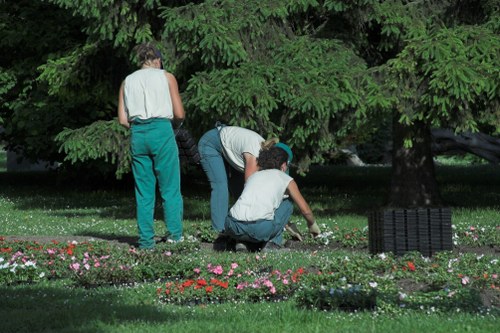Mastering Hedge Trimming in Manor Park: Your Ultimate Guide
Introduction to Hedge Trimming

Maintaining a beautiful garden requires regular hedge trimming. In Manor Park, where the climate and soil conditions are unique, proper hedge care is essential for the health and aesthetics of your landscape.
Hedge trimming not only enhances the visual appeal of your property but also promotes the growth and longevity of your plants. Whether you're a seasoned gardener or a homeowner looking to improve your outdoor space, understanding the fundamentals of hedge trimming is crucial.
In this article, we'll delve into the best practices, tools, and techniques for effective hedge trimming in Manor Park, ensuring your hedges remain lush, healthy, and perfectly shaped.
Why Hedge Trimming Matters

Regular hedge trimming offers numerous benefits beyond mere aesthetics. It plays a vital role in maintaining the health of your plants by preventing diseases and encouraging robust growth.
Key Benefits of Hedge Trimming:
- Promotes Healthy Growth: Trimming removes dead or diseased branches, allowing new growth to flourish.
- Enhances Appearance: Well-trimmed hedges provide a neat and orderly look to your garden.
- Controls Size: Regular maintenance keeps your hedges at a manageable size, preventing overgrowth.
- Improves Airflow: Thinning out dense foliage enhances air circulation, reducing the risk of fungal infections.
In Manor Park, where gardens are a source of pride for many residents, understanding these benefits can help you maintain a vibrant and healthy outdoor space.
Choosing the Right Tools for Hedge Trimming

Having the proper tools is essential for effective hedge trimming. The right equipment not only makes the job easier but also ensures precise cuts that promote plant health.
Essential Tools:
- Pruning Shears: Ideal for small branches and detailed shaping.
- Hedge Trimmers: Suitable for larger hedges, providing a uniform cut.
- Loppers: Perfect for thicker branches that shears can't handle.
- Safety Gear: Gloves, safety glasses, and protective clothing to ensure your safety while trimming.
Investing in high-quality tools can make a significant difference in the efficiency and outcome of your hedge trimming efforts in Manor Park.
Best Practices for Trimming Hedges

Adhering to best practices ensures that your hedges remain healthy and aesthetically pleasing. Here are some expert tips for effective hedge trimming:
- Know the Right Time: Trim hedges during the growing season, typically in late spring or early summer, to encourage new growth.
- Start with Clean Tools: Ensure all your trimming tools are clean and sharp to make precise cuts and prevent disease transmission.
- Cut at the Right Angle: Make cuts at a 45-degree angle to promote water runoff and prevent rot.
- Don’t Overtrim: Avoid cutting back more than one-third of the hedge at a time to prevent stressing the plant.
- Shape for Health: Maintain an open center to allow light and air to penetrate the foliage, reducing the risk of fungal infections.
By following these practices, you can ensure that your hedges in Manor Park remain robust and visually appealing throughout the year.
Types of Hedges and Their Trimming Needs

Diverse hedge types require different trimming techniques. Understanding the specific needs of each can help you achieve the best results.
Common Hedge Types in Manor Park:
- Boxwood: Prefers regular pruning to maintain shape; tolerate hard trimming.
- Privet: Fast-growing and ideal for formal hedges; requires frequent trimming to control size.
- Laurel: Dense and glossy leaves; trimming should focus on maintaining thickness.
- Holly: Requires careful trimming to preserve berries and prevent damage to spines.
- Beech: Responds well to shaping; trimming in early spring promotes lush growth.
Each of these hedge types has unique characteristics and trimming needs. Tailoring your approach ensures that your hedges remain healthy and beautifully shaped.
Seasonal Hedge Trimming Tips
Different seasons call for different trimming strategies. Adapting your hedge trimming routine to the seasonal changes in Manor Park can enhance the health and appearance of your hedges.
Spring: Focus on shaping and encouraging new growth. Remove any winter damage and thin out crowded areas.
Summer: Perform light maintenance to keep hedges tidy. Avoid heavy trimming to prevent stress during hot weather.
Autumn: Prepare hedges for winter by trimming back any long or overextended branches. Remove fallen leaves to prevent disease.
Winter: Minimal trimming is needed unless there is severe damage from storms or pests. Focus on protecting hedges from frost and freezing temperatures.
By following these seasonal tips, you can ensure that your hedges remain resilient and attractive throughout the year.
Common Mistakes to Avoid
Avoiding common hedge trimming mistakes can save time and prevent damage to your plants. Here are some pitfalls to watch out for:
- Overtrimming: Cutting too much at once can stress the plant and inhibit growth.
- Trimming at the Wrong Time: Pruning during dormant seasons can delay growth and reduce flowering.
- Using Dull Tools: Dull blades make uneven cuts, increasing the risk of disease.
- Ignoring Plant Health: Trimming sickly branches without addressing underlying issues can worsen plant health.
- Poor Shaping: Irregular shapes can lead to uneven growth and unbalanced hedges.
Being mindful of these mistakes and taking proactive measures can help maintain the health and beauty of your hedges in Manor Park.
Professional Hedge Trimming Services
While DIY hedge trimming is achievable, sometimes professional services are the best choice. Professionals bring expertise, experience, and the right tools to ensure your hedges receive the best care.
Benefits of Hiring Professionals:
- Expertise: Professionals understand the specific needs of different hedge types.
- Time-Saving: Saves you time and effort, especially for large or complex hedges.
- Proper Equipment: Access to specialized tools and equipment for efficient trimming.
- Consistent Results: Ensures uniformity and precision in trimming.
- Health Maintenance: Professionals can identify and address underlying health issues.
For residents of Manor Park seeking impeccable hedge trimming, hiring a professional service can be a worthwhile investment.
Cost of Hedge Trimming in Manor Park
The cost of hedge trimming can vary based on several factors, including the size and type of hedges, the complexity of the job, and whether you choose a professional service.
Factors Affecting Cost:
- Hedge Size: Larger hedges require more time and effort, increasing the cost.
- Accessibility: Hard-to-reach areas may require specialized equipment, adding to expenses.
- Hedge Type: Some hedges, like holly, require more careful trimming, influencing the price.
- Frequency: Regular maintenance contracts may offer discounts compared to one-time services.
- Additional Services: Services like shaping, fertilizing, or pest control may incur extra costs.
On average, homeowners in Manor Park can expect to spend between £50 to £150 for standard hedge trimming services, depending on the aforementioned factors.
DIY Hedge Trimming Tips
If you prefer to trim your hedges yourself, here are some practical tips to achieve professional-looking results:
- Plan Your Trim: Assess your hedges and plan the trimming process, considering the desired shape and size.
- Gather Tools: Ensure you have all the necessary tools, including sharp shears, trimmers, and safety gear.
- Start with Lower Branches: Trim lower branches before moving to higher ones to create an even shape.
- Maintain Symmetry: Step back periodically to check the symmetry and balance of your hedges.
- Clean Up: Remove all clippings and debris to prevent pests and diseases.
By following these DIY tips, you can maintain beautiful hedges without the need for professional assistance.
Eco-Friendly Hedge Trimming Practices
Adopting eco-friendly practices in hedge trimming can benefit both your garden and the environment. Here are some sustainable tips:
- Use Manual Tools: Whenever possible, use manual shears and trimmers to reduce energy consumption.
- Recycle Green Waste: Compost your trimmed branches and leaves instead of sending them to landfill.
- Choose Native Plants: Native hedges are better adapted to local conditions and require less maintenance.
- Water Efficiently: Ensure hedges are well-watered before trimming to minimize water stress.
- Natural Pest Control: Use organic methods to manage pests, avoiding harmful chemicals.
Implementing these eco-friendly practices ensures that your hedge trimming in Manor Park contributes to a sustainable and healthy garden ecosystem.
Maintaining Hedge Health
Keeping your hedges healthy goes hand-in-hand with regular trimming. Here are some tips to ensure your hedges remain in top condition:
- Proper Watering: Ensure hedges receive adequate water, especially during dry spells.
- Fertilization: Apply appropriate fertilizers to provide essential nutrients for growth.
- Monitor for Pests: Regularly check for signs of pests and treat them promptly.
- Ensure Good Airflow: Avoid overcrowding by thinning out branches to promote air circulation.
- Soil Health: Maintain healthy soil by adding organic matter and avoiding compaction.
By focusing on these aspects, you can maintain the overall health and vitality of your hedges in Manor Park.
Conclusion
Hedge trimming is an essential aspect of garden maintenance that enhances both the beauty and health of your plants. In Manor Park, understanding the unique requirements of your hedges, using the right tools, and following best practices can make all the difference.
Whether you choose to undertake hedge trimming yourself or hire professional services, the key is consistency and attention to detail. By implementing the strategies outlined in this guide, you can ensure that your hedges remain a stunning feature of your Manor Park garden for years to come.
Don't wait to transform your garden! Contact us today to learn more about our expert hedge trimming services and book your service now.